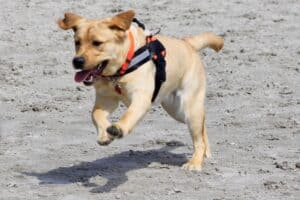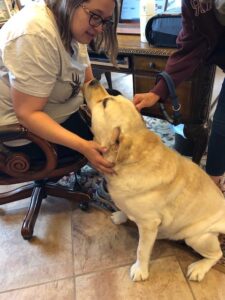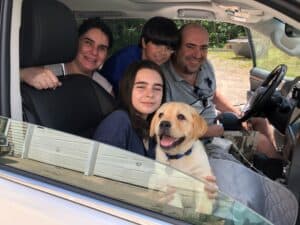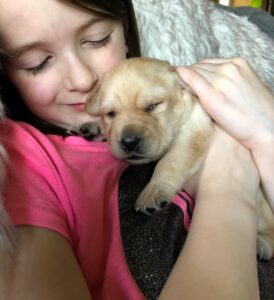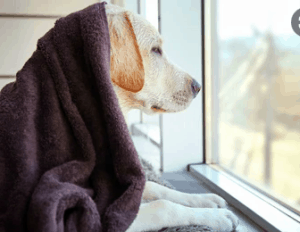
At first glance, your pet may seem to be a perfectly normal adolescent young dog—happy and healthy and growing. Yet, they may be one of the avalanche of about 3 million U.S. pets purchased or adopted to brighten lives of people during the height of the Covid-19 pandemic. We had many go out of here at Endless Mt. Labradors.
Yet, when approached by a strange dog or animal—or exposed to a new environment, the pet is not as carefree as she usually is. Sometimes he/she responds in fear, or panic. Even going to the vet may be more stressful than ever for both her and the owner.
This situation, unfortunately, is normal. Instead, she is one of an unknown number of dogs that are now, and forever more will be, ‘products of the pandemic.’ While they were in the critical formative weeks of early life, especially if you got a puppy, particularly during 2020, the behavior and socialization of this “Generation P” of dogs were affected to varying degrees by their lack of normal contact and experiences during the long months of quarantine isolation.
“The first three months of a puppy’s life are extremely important to its social development,” said Dr. Christopher Lea, assistant clinical professor in the Department of Clinical Sciences in Auburn University’s College of Veterinary Medicine. “Primary socialization occurs during the first three to six weeks with a puppy’s littermates. Then there is a secondary period of development from six to 12 weeks. This is when a puppy learns to interact with humans.”
Cat Clutton, a certified dog trainer and founder at ReKalibratedK9 Dog Training Services in Opelika, Alabama, said this early three-month period is critical to a dog’s lifetime behavioral patterns.
“During this time frame, puppies learn how to properly bond and socially communicate with both other dogs and people, as well as how to interact with and respond to different environments,” Clutton said. “Simply put, dogs that are not properly exposed to a variety of individuals, objects, sights, sounds, smells and environments during this period may always be fearful of some of those same things.”
Many of the pups of “Generation P” had few, if any, of the experiences and contacts Lea and Clutton describe. Instead, their early months were largely spent in the company of their owners and perhaps with older dogs in their households. To make matters worse, a larger than usual number of pandemic dog adoptions were to first-time owners more likely to make novice mistakes with socializing puppies correctly even in a normal environment. This produced a perfect storm of bad circumstances at a critical time in the developmental stages of these dogs.
Even in the case of experienced owners acting responsibly during pandemic isolation—avoiding crowds, gatherings and outings in dog parks, while generally being as antisocial as possible—then many of their dogs have become antisocial as well—especially with the 6-foot rule which had people pulling their dog back away from people—perhaps communicating they are dangerous. And of course, dogs pick up when their owner is nervous too!
While these dog ‘teens’ are more likely than usual to have behavioral problems socializing with strange people, places and other dogs, the largest problem both trainers and vets are reporting so far is due to separation anxiety. As the COVID-19 situation improves, dog owners who have been homebound for months are increasingly beginning to return to work and school. Suddenly, dogs that have had constant human companionship for their entire young lives are finding themselves bored and alone for much of the day. (Jayne Hart)
“We are seeing an uptick in pets having issues with separation as owners return to their regular schedules,” said Dr. William “Blue” Brawner, owner of PetVet Animal Health Center in Auburn, Alabama. “These are dogs that have never been left alone all day. They’ve been fine up to this point. But as a lot of owners return to normal routines, we are seeing more dogs that have trouble adjusting to that.
“This is a big one since most COVID-19 pets were happy to have their owners staying home all day,” he noted. “Disrupting this pattern can trigger destructive behavior, and destructive behavior is a big reason people relinquish their pets to animal shelters.”
The sooner owners realize their dogs need help and act to get it, the better the likely outcome.
There is hope: With patience and consistency, they can be trained. And Lea, Brawner and Clutton are all optimistic that most conscientious owners will be willing to get their pets the help they need.
Tips for pandemic pup owners:
Keep up a regular routine: Even if you are still working from home, establish a regular schedule for your dog’s daily activities. Try to set feeding, walks and play at the same times each day on a schedule that will work whether you are home or back at work.
Use a crate
If you haven’t already, begin crate training to provide a secure option for leaving your dog alone for short periods. Never use a crate as punishment. Instead, start by giving your dogs meals, treats and toys in the crate, always leaving the door open so the dog won’t feel confined. Soon the crate will become your dog’s safe place.
Don’t force the issue
Taking an adult dog that is fearful or unsure of how to behave appropriately with other dogs and people and forcing them into interactions without taking the appropriate steps is likely to make the problem much worse. This also goes for environmental soundness: “Flooding” a dog by forcing it into uncomfortable environments will not change its feelings about those spaces.
Seek professional training
Dogs uncomfortable with unfamiliar environments, people or other dogs after the age of approximately five months need training plans that include counter-conditioning rather than just simple socialization or exposure. Counter-conditioning involves attempting to change a dog’s emotional response to a trigger, making it a better fit for dogs that have already developed negative associations with certain experiences.
Ask if your vet clinic is a ‘fear-free’ practice
Many veterinarians today are trained in “fear-free” techniques when it comes to dealing with nervous pet patients. Dogs, and cats, are able to visit the veterinary clinic to explore the office, get treats from staff and generally familiarize with the people and place without the trauma of treatment. (Austin American Statesman, periodical, 2121)
A creative approach can still provide the benefits of socialization while also following recommendations for social distancing.
Tips for socializing dogs in a socially distant world:
The following activities will help guide pet owners through dog socialization during COVID-19, helping to prepare their animals for life when physical distancing is not the norm. During this process, it’s important that pet owners reward engagement with praise, play, and treats to create a positive experience, which encourages pets to enjoy new experiences without becoming fearful or aggressive.
Go for a walk: This provides opportunities for exposure to a variety of new stimuli and experiences. Just like with other members of your family, be sure to maintain at least 6 feet of separation from other people and other dogs.
Go for a car ride: Short, consistent rides get pets used to traveling in a car.
Let dogs explore indoors: Allow them to inspect a variety of toys or common home objects. Be sure to supervise them so no injuries, chewing, or ingestion occurs.
Prepare for veterinary visits: Get dogs used to different types of handling, such as playing with their paws, tail, or ears. This will help get them ready for nail trims, thermometers, medication, and other exam activities.
Also, have people come over outside in a socially distanced way and maybe bring the dog a treat or interact with the dog while staying distanced from the people. Doggy day care, if that’s a possibility, also can help dogs interact with other people and dogs.
Think of it like a human having panic attacks on a daily or weekly basis. That’s worrisome in dogs as well. A vet might also be able to help with some anti-anxiety medicine (for the dog, not for the humans).–Donna Stanley, Endless Mt. Labradors. Copyright 2021. All images and text can only be used by permission only from Donna Stanley.

